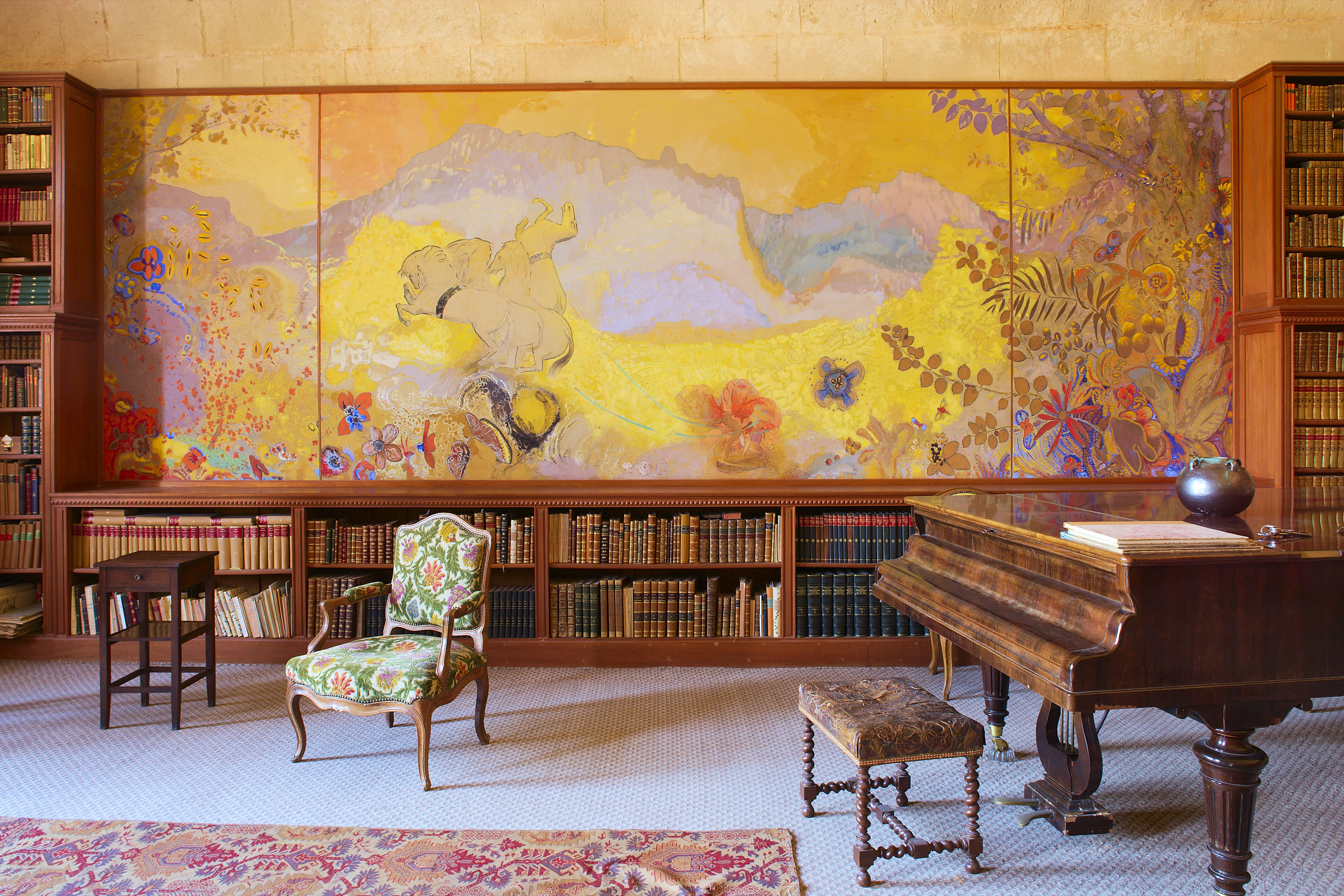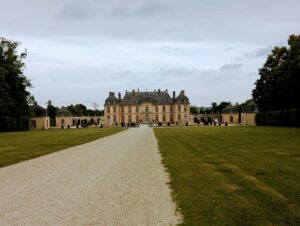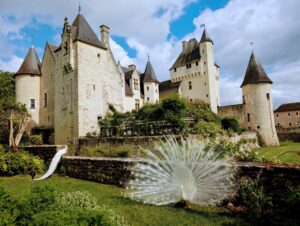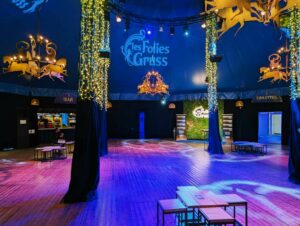The Fontfroide Abbey, the interactivity at the disposal of History

In the heart of the region newly named Occitania is nestled one of the most famous Cistercian abbeys, the Fontfroide Abbey who had survived through the ages, while remaining intact and thus being able to accommodate its 113,000 annual visitors to attend the various events proposed by the heirs of Gustave Fayet. His family keeps alive the place since the acquisition of the site by their grandfather in 1908. A auction at the candle, instead of an auctioneer American archaeologist George Gray Barnard who reserved a destiny international to all his ecclesiastical acquisitions because he used to give a second life to the elements of religious art (cloisters in particular) in the United States, which Rockefeller had in particular after bought his collection of cloisters.

 Views on the gardens of the abbey (photo credits: Alexandre Plateaux)
Views on the gardens of the abbey (photo credits: Alexandre Plateaux)
An Abbey, muse of plural artists
Thus, paying particular attention to the religious heritage of the site but while exploiting its artistic potential, the direction has initiated for the second consecutive year to the nocturnes summers “in sounds and lights”, in collaboration with the specialist in this field Patrice Étienne and set to music by Stephen Sicard, presenting projections of monastic scenes on the walls of the Abbey and notable landscapes of the region captured by drones, and navigable by the visitor with the help of a command on a tactile terminal, all accompanied by medieval music.



Nights of Fontfroide and its play of light on the abbey, a well and the vegetation (without the sound …) (photo credits: Alexandre Plateaux)
Note then the annual reception of the Gregorian Choir of Paris during the Holy Week and a set of 60 choristers acclaimed on Holy Monday by 500 spectators, especially to “reload the stones” as summarized Laure de Chevron Villette, rear-small daughter of Gustave Fayet and manager of the place with her husband Nicolas de Chevron Villette.
Another admirer of this abbey, Henri Gaud, abbey photographer, establishes a residence of artists over 2 years with 12 photographers, and also, giving the edition of a book “12 regards” in 2011, presenting many facets passed under the lens of his colleagues.
In addition, Jordi Savall, international figure of the viola da gamba, revealed to the public by the work “Every morning of the world”, has been living in residence for 11 years at the abbey (at the instar before him the painter Odilon Redon), giving rise, under his guidance, this year to the 11th edition of the Festival Music and History, with a series of 10 concerts between 15 and 19 July.
He even took advantage of the acoustics of the abbey to record at night (so as not to disturb the flow of day visitors) a record in 2005, awarded “Diapason d’Or”.
Another figure of the place, Odilon Redon, symbolist painter of his condition and great friend in his time of Mr Fayet, whose centenary of his death is celebrated by an exhibition within the abbey.
A prolific friendship born of a meeting in 1900 in Paris tied around an interest of the latter for his collection of “Blacks” and a photo of the two comrades dated 1910 is exhibited in one of the chapels of the abbey among other pastels signed by Redon, representing family elements and other more floral and symbolist dated between 1900 and 1910, from the Mr Fayet collection.





Odilon Redon Centenary exhibition in the abbey including a photo of the time with Odilon Redon (on the right) and Gustave Fayet (on the left) and his family together.
Below, the facsimiles of Odilon Redon: Simone Fayet with the doll (1906), Caliban on a branch, Béatrice (photo credits: Alexandre Plateaux)
So-called “privilege” visits are offered, including the library, Temple of Odilon Redon, who met regularly with his great friend Gustave Fayet, to play the piano or browse one of the 5,000 books stored in this museum room. Indeed, it contains three monumental triptychs of the artist (on several tens of square meters of surface), covering two sides of walls, taking up fantastic themes dear to Redon, the chariots, the spooky flowers, and resuming the faces of the members here from the Fayet family and the staff of the Abbey appearing in the landscape, like flying creatures but nevertheless more colorful than his “black” period, as a cultural testament of all his work and among the last (since painted in 1911, and his last Christmas on the site was in 1915) and among the largest.

 The triptych of Odilon Redon in the library (photo credits: Alexandre Plateaux)
The triptych of Odilon Redon in the library (photo credits: Alexandre Plateaux)
Another part of this visit, the Gustave Fayet room exposing to the public the artistic side of this all-rounder, industrialist, painter, farmer, traveler … A collection of blotting inks follow between 1912 and 1925, including for some freely inspired by the work of representation of the phantasmagorical flowers of Redon. Then there were other media to discover, including ceramics and tapestries of large format and Art Deco trend, with free forms, which had great success at the end of his life, woven, according to his drawings, in his factory in the rue Dauphine, known as “the Atelier de la Dauphine”. The visitor will also be able to contemplate his last works were “black” drawings of olive trees, taken from photographs in Mallorca and realized in 1924 in Indian ink, with very striated features.


Gustave Fayet room and series of watercolors on blotting paper (1912-1925) (photo credits: Alexandre Plateaux)


 Self-portrait of Gustave Fayet (1901), yellow carpet pattern of flowers (1920-1925) (photo credits: Alexandre Plateaux)
Self-portrait of Gustave Fayet (1901), yellow carpet pattern of flowers (1920-1925) (photo credits: Alexandre Plateaux)
Finally, another event of the summer 2016, the installation by helicopter of the Cross of the peak of Fontfroide (see cover photo), freshly renovated (of unknown dating) with the assistance of the ironwork “Farga Catar”, who came back overhang the massif in full natural regional park of Narbonnaise, July 9 in the morning.
This Cross, protector of the site, will come to the top of 2 hectares of terraced gardens developed by the Fregoze, an Italian family that has given several abbots, and historically organized since its creation in the 16th century, a real reservoir of animal species since site classified LPO or refuge site, also including 40 hives. These spaces are adjoined by a rose garden of nearly 3,000 species, rescued from a fire in 1986 beside 2,000 hectares of scrubland. A site conducive to floral events, from 7 to 9 October 2016, the holding of the 10th edition of an orchid fair, “Orchids to Fontfroide”, with producers from around the world.
Also several hectares of vineyards in the Fontfroide area lead to the development of a variety of 15 different types of wines.


 Helicopter of the Cross on the massif of Fontfroide (photo credits: Alexandre Plateaux)
Helicopter of the Cross on the massif of Fontfroide (photo credits: Alexandre Plateaux)

 View of the rose garden and the porch leading to it (photo credits: Alexandre Plateaux)
View of the rose garden and the porch leading to it (photo credits: Alexandre Plateaux)
An Abbey, with multiple lives
Courts of the era of abbots commendatories of the 18th supplanted by Italian gardens, adjoining buildings of Romanesque style with mullioned windows, including cells more comfortable than the dormitories of the time.
What is striking is the reading of architectural remains in time, from its founding in 1093 to the last community of monks, punctuated by two periods of abandonment of the Abbey, including 50 years after the Revolution, which was intended to serve as a national good as a stone quarry, then between 1901 (October 1, 1901, the date of the law on associations ringing the departure of the monks.) and 1908, so little time in the end compared to the thousand years of History of Cistercian monks who were affiliated by Saint Bernard in 1145, observing the rule of St. Benedict while making vow of poverty.
The monks and the lay brothers were originally separated in their respective spaces since they were meant to support the cultures.
There were up to 25 barns representing 25,000 hectares of land and 20,000 head of cattle to be exploited; until the 18th century, when the renting augured.
The improperly called Court Louis XIV or Court of Works, concentrated the various multitask workshops of the lay brothers who were not forced to silence but only to the Sunday services, thus feeding the whole community, stored in a cellar semi-buried, under the rock, room also the coolest of all the building.

 The cellar and a blacksmith animation stand of the “Farga catar” (photo credits: Alexandre Plateaux)
The cellar and a blacksmith animation stand of the “Farga catar” (photo credits: Alexandre Plateaux)
This separation between tenant farming and sharecropping, between lay brothers and Cistercian brothers, sounds the particularity of the Cistercian communities with elements of separation as the wall of the “alley” separating the 2 communities, contributing to the constitution of characteristic provisions of the Cistercian abbeys.



Louis XIV court (photo credits: Alexandre Plateaux)
A Gothic cloister of the 13th century, was built thanks to the subsidies of the fruit of the enrichment so much disputed by Saint Bernard, who preferred that the gifts and incomes of various natures be reinvested, which gave rise to a swarming of the community on others places like the abbey of Poblete, Spain.
Another sign of this enrichment, the original columns of the XIth century, in pink sandstone of the massif of Fontfroide (due in part to the presence of iron oxide) evolving marble columns adjoining the XIIIth century, in the cloister mainly put up to date at this time.
The cloister also includes a chapter house, room assigned to the tasks of the week by the abbot, with monks who had to denounce, by “healthy” denunciation, the violators who had departed from the rules, from the abbot who governed then the penalties.
Room now decorated with an annual work, with the assistance of the Languedoc-Roussillon region, this year represented by the boat of the visual artist Marc Couturier.


 Views on the cloister and the chapter house with the 2016 installation of Marc Couturier (photo credits: Alexandre Plateaux)
Views on the cloister and the chapter house with the 2016 installation of Marc Couturier (photo credits: Alexandre Plateaux)
Many contributions appeared over the ages, including stained glass windows with salvaged glass and other pieces of glass such as those from the Saint Rémy de Reims cathedral after the bombing of World War I, with a view to creating “stained glass windows”. “, Marking this assemblage of styles and periods under the aegis of Mr Fayet.
Second characteristic to show the attachment of Mr Fayet to the color that brought an ambitious touch for a Cistercian abbey accustomed to austerity, it is the supplantement of the stained glass windows of greyish origin of the abbey by stained glass windows in 1914, and with mixed compositions of which one (arrival at the end of the cycle in 1925) representing a Christ in Glory coexisting with secular symbols (representation of signs of the zodiac), thanks to the return to a technique of the Middle Ages that was the “hue in the mass “rather than painted glasses (usually adopted from the fifteenth century). In the south aisle, stained glass windows represent saints in connection with the members of the family, as a nod to its proximity to the master of the place Mr Fayet.
This set of updates brought a lot of light welcome to the benefit of this thousand-year-old abbey, including a nave before the choir post-Romanesque, which deviates by its ceiling height of 21 meters high, a real feat by standards of his time.
In association with the master glassmaker Richard Burgsthal, who made the majority of these stained glass mosaics, Gustave Fayet founds a sandstone in the Bièvre Valley, in Igny, using these techniques of the Middle Ages, we find also blues and colors. red very deep as in the cathedral of Chartres (see red stained glass of Saint Nicolas).


 The famous “salad stained glasses” of the former dormitory (photo credits: Alexandre Plateaux)
The famous “salad stained glasses” of the former dormitory (photo credits: Alexandre Plateaux)
Indeed, between 1908 and 1925, the year of his death, Mr Fayet devoted most of his life to the renovation of buildings in poor condition, while the community of monks had only seven members, had concentrated in the refectory, which was decompartmentalized by Mr Fayet who modernized the entire building by adding his “greatness of artist” by the addition of decorative elements found throughout the world (Buddhas, statues, elements luminaries including Andalusian candelabra or azuleros, signs of his many travels).


 Among the 250 objects brought by Gustave Fayet and his wife to adorn the site, mostly from Asia and Spain. Here, lanterns of Spanish procession enthroned in the “alley” and in one of the alleys of the cloister or this cherub having found his eternal posture in the park (photo credits: Alexandre Plateaux)
Among the 250 objects brought by Gustave Fayet and his wife to adorn the site, mostly from Asia and Spain. Here, lanterns of Spanish procession enthroned in the “alley” and in one of the alleys of the cloister or this cherub having found his eternal posture in the park (photo credits: Alexandre Plateaux)
The visitor can discover at his own pace the building thanks to one of dozens of portable audio-visual and polyglot tablets, provided free of charge, reacting to geolocated beacons at the option of the visit, delivering extensive information also available on the application of the Abbey .





The abbey from every angle (photo credits: Alexandre Plateaux)

 2 hectares of lush Mediterranean vegetation to browse and indulge in lyricism (photo credits: Alexandre Plateaux)
2 hectares of lush Mediterranean vegetation to browse and indulge in lyricism (photo credits: Alexandre Plateaux)

 The local handmade cutlery by the blacksmith of the “Farga Catar” present in the Louis XIV Court (photo credits: Alexandre Plateaux) near the newly three-star Michelin Green Guide restaurant of the Abbey.
The local handmade cutlery by the blacksmith of the “Farga Catar” present in the Louis XIV Court (photo credits: Alexandre Plateaux) near the newly three-star Michelin Green Guide restaurant of the Abbey.







